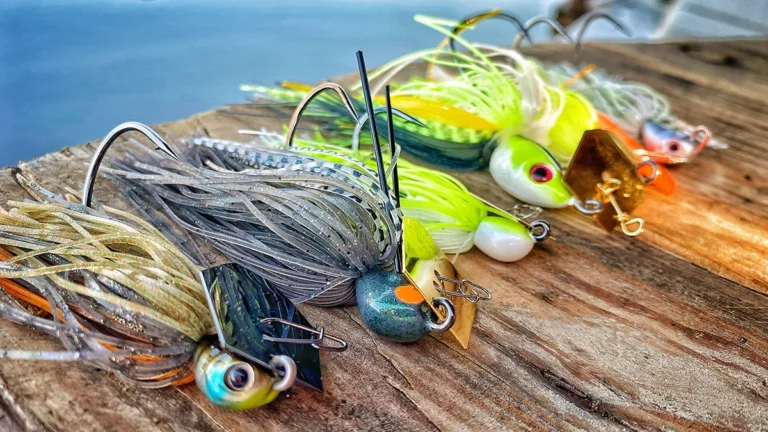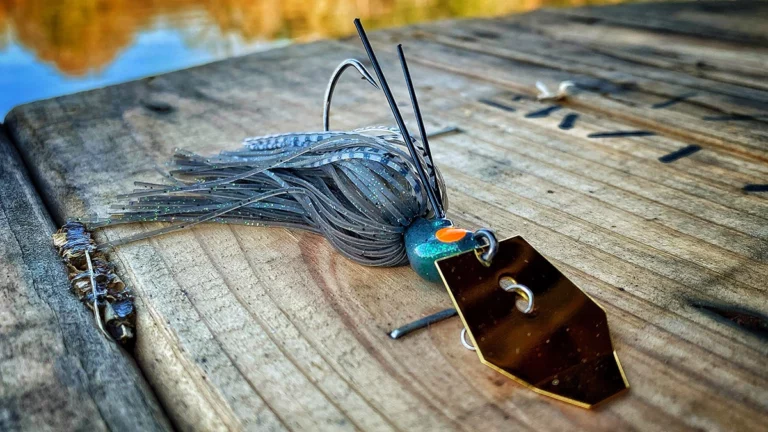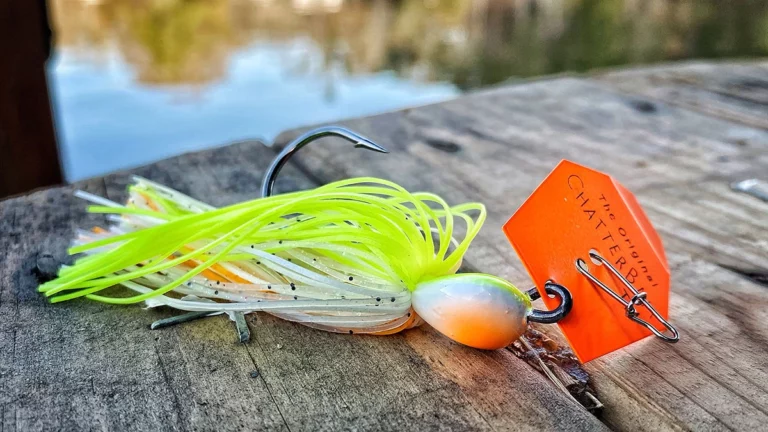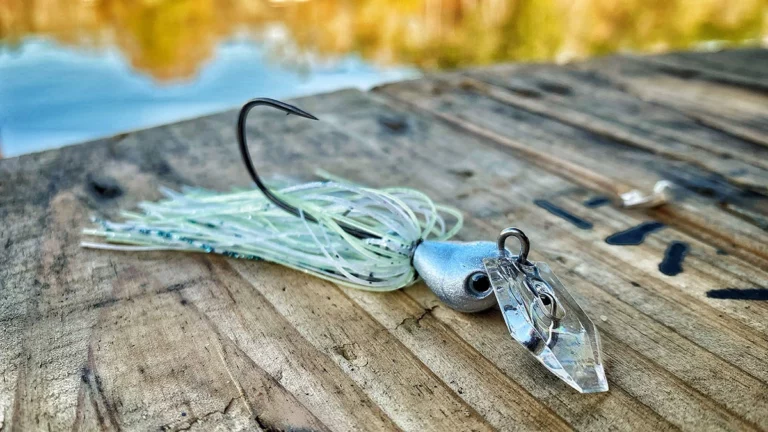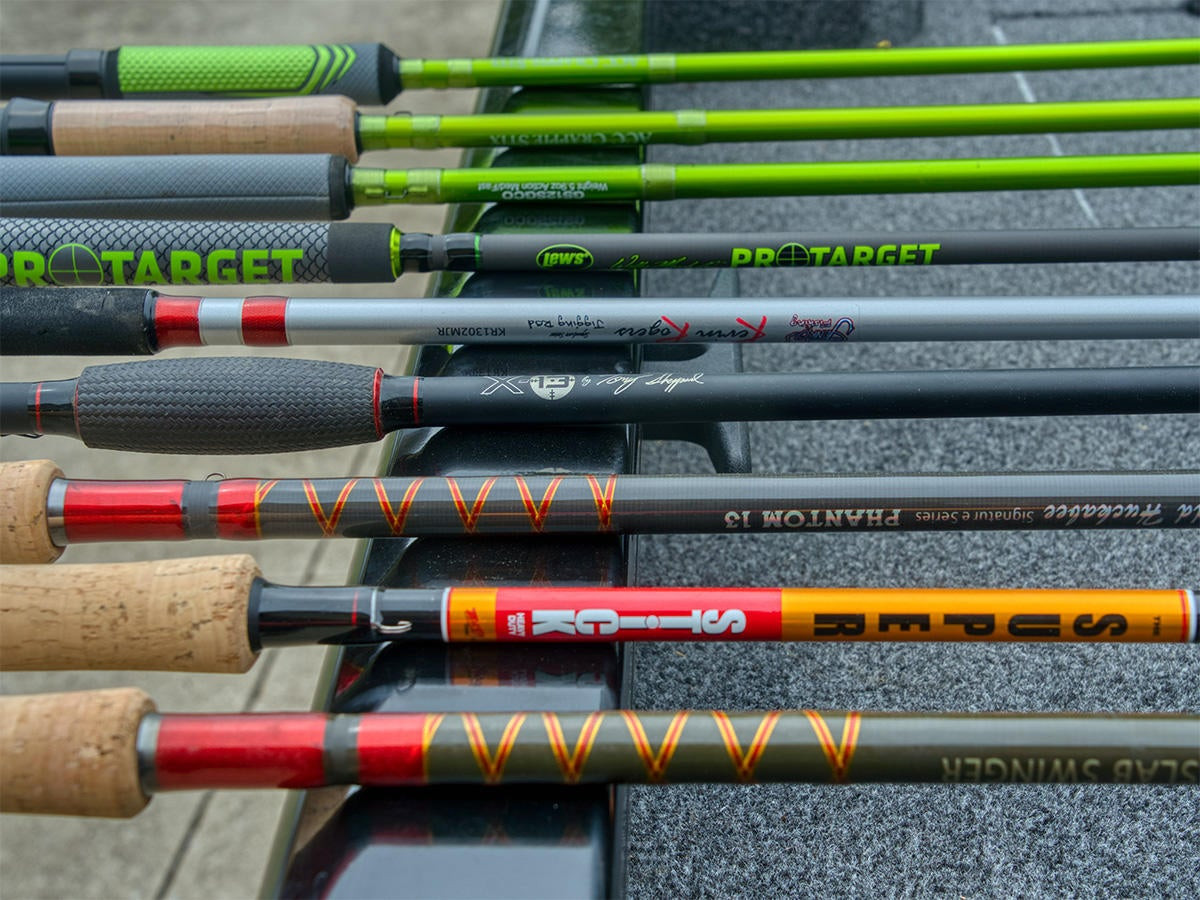ChatterBaits are an outstanding way to catch big bass throughout the entire country. Whether you’re fishing in clear water, dirty water or anywhere in between, you can usually find a willing taker whenever you’re tossing a ChatterBait around. They took the bass fishing world by storm when they were first introduced and unlike many trendy lures, their effectiveness never really waned. To this day, people catch giant bass on these fishing lures every single day.
After fishing with ChatterBaits for many years, we wanted to put together a quick guide that will help you maximize your success with them. These are some of our favorite big-fish baits and regardless of your particular skill level, you’ll catch some fish with them.
OUR TOP PICKS
- Z-Man/Evergreen Chatterbait Jack Hammer – Buy from Tacklewarehouse
- Z-Man Project Z Chatterbait – Buy from Tacklewarehouse
- Z-Man Crosseyez Chatterbait – Buy from Tacklewarehouse
- Z-Man Blade Chatterbait – Buy from Tacklewarehouse
- Z-Man Jack Hammer Stealthblade – Buy from Tacklewarehouse
- Z-Man Chatterbait Minimax – Buy from Tacklewarehouse
WHAT EXACTLY IS A CHATTERBAIT?
ChatterBaits are an interesting hybrid bass-fishing lure that combine characteristics of three particular lures: The flash of a spinnerbait, the vibration of a spinnerbait and the overall profile of a skirted bass fishing jig. It can be worked in all levels of the water column and around just about any cover you can imagine.
The Z-Man ChatterBait popularity created a broader category of similar lures commonly called “bladed jigs.” This terminology comes from the lure’s unique and incredibly popular design that essentially includes a skirted jig and a vibrating blade attached to the top. This creates an erratic vibration action throughout the retrieve which is meant to be primarily retrieved horizontally throughout the water column.
A big reason for its success is due to its ease of presentation; it doesn’t take a professional to fish it correctly. In most situations, you can cast these lures towards good-looking cover and begin reeling it towards you the moment it hits the water. With a few erratic twitches of the rod tip and a few changes of your retrieve speed, you’ll quickly learn how effective the ChatterBait is at enticing reaction strikes from otherwise wary bass.
CHATTERBAIT COLOR RECOMMENDATIONS
If you’ve ready any number of my bass fishing articles, you’re well aware that I prefer to keep my lure color selection as simple as possible. Not surprisingly, the same concept applies when I’m choosing my ChatterBait colors.
Z-Man has done an incredible job at developing a myriad of colors that mimic a wide variety of prominent forage throughout the country. Whether you’re surrounded by threadfin shad, bluegill, crappie or even crawfish, you’ll find an outstanding color that will work wonders for you. With that being said, however, there’s no need to get too carried away when you’re experimenting with this technique for the first time. So before you spend hundreds of dollars on different colors, let’s run through some very broad guidelines that might make your selection process much easier.
- White and/or shad: As earlier mentioned, Z-Man offers a bunch of options in this range but let’s keep it as simple as possible. These white- and shad-colored patterns perform best when the bass are feeding on minnows or whenever you’re fishing in super clear water. Upon further inspection, you’ll find some colors that have some sparkles and others that have a fairly matte-type finish. The rule of thumb is simple: In sunny conditions, choose the colors with a bit more flash or sparkle to ‘em. When it’s overcast, those pearly-type or matte colors tend to perform best when the bass are actively feeding on baitfish.
- Green pumpkin: Don’t make this one too complicated. As you’re fishing down a bank and notice a bunch of bluegill hanging around dock posts and other types of cover, just tie on some type of green-colored ChatterBait. It’s tempting to get crazy with the different color options but avoid it the best you can. I can remember a tournament I was fishing years ago and I was throwing a white-colored ChatterBait and not getting a single bite. Meanwhile, my buddy saw a few bluegill hanging around dock posts and ended up catching a 25-pound limit just a mile away from me. The particular green color doesn’t normally seem to matter. Just make sure it’s green.
- Red: This color got super popular after professional angler Jordan Lee put an absolute butt whoopin’ on a bunch of big bass during the Alabama prespawn period a few years ago. When the water temperatures are between roughly 42 and 55 degrees in the late-winter months, make sure you have some sort of red-colored ChatterBait tied on. Fish it around any shallow, isolated cover that may be leading into potential spawning pockets and hang on tight.
- Dark blue or bright orange/chartreuse: If you find yourself fishing in especially muddy water, don’t be afraid to go with a dark-blue or orange/chartreuse-colored ChatterBait. It doesn’t look that great after you rig it up because it doesn’t really look like much you’d naturally see in the water. But the important thing is that it helps the bass see and track your ChatterBait in these low-visibility conditions. This is another scenario in which you don’t have to get sexy with your particular color selection. These two colors work in dirty water and don’t ask me why. But just trust me on this one.
CHATTERBAIT TRAILER SELECTION SIMPLIFIED
It’s important to note the importance of using some type of soft-plastic trailer on your ChatterBait, regardless of the situation. Not only does it add some necessary bulk to the overall profile but it also provides a more natural look as it swims horizontally throughout the water column. Keeping within our theme of simplicity, here are three soft-plastic trailer types I strongly recommend for ChatterBaits. In regards to color selection, it’s good practice to match the color of your soft-plastic trailer to the skirt color of your ChatterBait.
- Shad profile: If you’re fishing your ChatterBait through heavier cover such as aquatic vegetation or fallen trees, a slimmer and more streamline profile trailer seems to work best as it comes through cover easier. I guess it’s worth stating the obvious that these shad-shaped trailers also work very well when the bass are actively feeding on baitfish. I’ve had the most success using the Z-Man Razor ShadZ and the Z-Man DieZel MinnowZ (buy here).
- Creature bait: Yes, I know creatures and crawfish don’t just swim around horizontally all throughout the water column. But these soft-plastic trailers with added appendages displace more water which allow the bass to detect their presence with their lateral lines. I like to use these types of trailers when I’m around a lot of bluegill in order to more closely mimic their thicker body profiles and also whenever I’m fishing in murky waters; the extra action and flapping of the appendages helps the bass feel and track the lure with ease. I like to use the Z-Man Turbo CrawZ (buy here) and Hella CrawZ(buy here) for these applications.
- Grub: This is the type of trailer I probably use the least because it seems to perform best on a much smaller, finesse-sized ChatterBait and I don’t fish that way as often. But if you’re fishing in a creek, river or a pond, you should absolutely have some type of soft-plastic grubs nearby so you can put ‘em on your smaller ChatterBaits. In my experience, the Z-Man GrubZ (buy here) tends to have a lot of great actions and can last months on the back of your ChatterBait.
CHATTERBAIT SIZE, ROD AND REEL RECOMMENDATIONS
The large majority of your ChatterBait fishing will be done in shallow water; most likely in less than six feet deep. Now, this can certainly differ depending on your particular location so don’t take that as absolute gospel. But I think that’s a very generic range on which most of us can agree.
You’re going to find all kinds of different weights of ChatterBaits but don’t let that get you confused or overwhelmed. In my personal opinion after fishing with these lures for almost two decades, I think you should use the heaviest ChatterBait with which you can get away.
I know a lot of folks use a 3/8-ounce ChatterBait for a wide variety of situations but I personally prefer a heavier 1/2-ounce ChatterBait whenever running down the bank and fishing shallow water. I say that because due to the nature of the bait and the resistance of the blade on top of the jighead, a lighter ChatterBait tends to rise in the water column throughout the retrieve. This can be negated by slowing your retrieve but oftentimes big bass like this bait fished quickly, so this can hurt your chances of getting a bite. To get the best of both worlds, I use the 1/2-ounce size so it stays at-depth better throughout the entirety of the retrieve. Not to mention, this added weight allows for more accurate casting and longer-distance skipping underneath overhanging cover.
We can get pretty far into the weeds when it comes to ChatterBait rod selection, so I’m going to run an entirely seperate piece on that in the coming months. But for now, I’m absolutely positive you can have a bunch of success using a 7-foot, medium heavy-action casting rod with 15- to 17-pound test. So don’t get spun out and think that you have to automatically spend $200 on some ChatterBait-specific rod. Use these recommendations and you’re going to be just fine, regardless of the type of ChatterBait you choose to use.
Choosing the right gear ratio reel is fairly important when it comes to this technique but yet again, there’s no need to get all wired up about it. After a lot of experimenting throughout the years, I’ve settled on using a high-gear ratio reel such as a 7.1:1 or faster. It’s not necessary but I like the higher IPTs (inches per turn) because it helps me get the blade of the ChatterBait wobbling the second it lands in the water.
Remember, these baits sink fast after the cast so it’s important to get them high in the water column quickly to clear the hook of any snag-inducing obstructions. You’ll also get a lot of ChatterBait bites from behind, meaning the bass will chase your lure out from their cover-oriented ambush points and, more or less, push the bait towards you. When this happens, this created a bunch of extra slack in your line and a high-gear ratio reel helps you retrieve said slack quickly in order to execute a timely and effective hookset.




